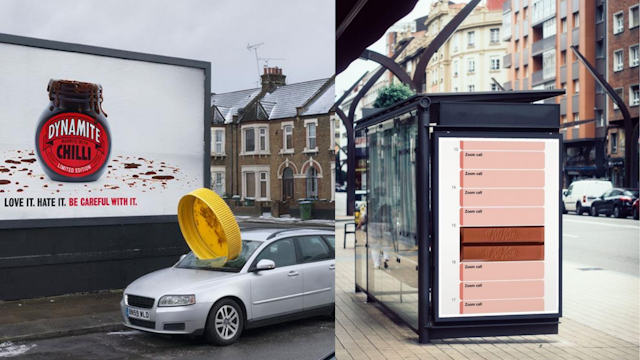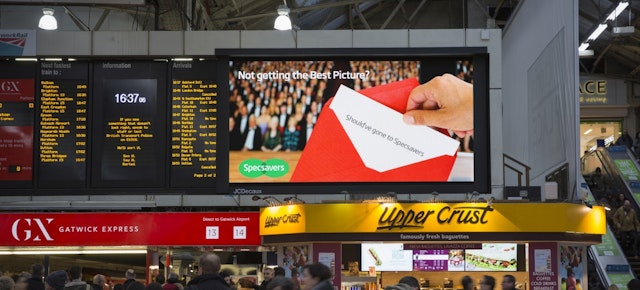Can Out of Home ads really create PR fame - or will high expectations hurt the industry?
Rarely a week goes by without an inspired billboard, bus-shelter poster or bus livery going ‘viral’ on social media. You'd almost think the work was made for that purpose. Social media's provided somewhere for impactful out of home ads to further resonate but is the congratulatory feedback loop blinding marketers to the true value of the medium – reaching real people?
If you are in the smallish circle of social-media active marketers who gleefully share nice ads with captions like “clever that”, you’ll have noticed last week a clever exploding ‘dynamite’ Marmite ad, complete with a huge scattered lid, and a mocked-up ad for KitKat from One Minute Briefs contestant Sam Hennig, who was absolutely struck by the warm reception for his idea.
Both ads drove applause and debate. Only one ran in the real world.

Some onlookers questioned whether you even needed to run the physical OOH ad. Why not just mock it up and tweet it? More questioned whether the top of class OOH executions are supposed to reach real people – or merely awards juries.
In the last decade, the medium’s purpose has evolved, The Drum explores why.
Pain with gains
UK out of home ad spend was 61.5% of 2019 levels, even buoyed by a huge government comms drive, according to the IPA. Meanwhile, industry body Outsmart said the revenue decline in the first half of 2020 sat at 44.8% year-on-year. Lockdowns swallowed OOH footfall and strangled marketing budgets. Similarly, marketers were obsessed with finding at-home screens however they could.
Alistair MacCallum, chief executive of out-of-home specialist agency Kinetic Worldwide says footfall didn’t fall as low as many assumed. Only 30% of people could actually work from home, for example. “19 million people still went to work every day, 30% of school kids were still in school. Many of us went to supermarkets once or twice a day just to talk to someone.”
Not all regions locked down equally. Anonymised mobile data tracked population activity to offer helpful heat maps and work out worthwhile sites. Meanwhile, OOH networks worked to digitise their networks and buying platforms. Buyers can now run hyper-local campaigns within the hour without even lifting a phone. And digital out of home sites, have doubled in number in the last four years in the UK. They also account for a third of spend in the US. Marketers are also excited about the creative opportunities afforded by the outdoor screen.
There’s more incentive to show off, too. Over the last two decades, most people acquired phones, with cameras, linked to mass audiences through social media. People on ’active journeys’ could suddenly, and immediately, share good outdoor creative. In the moment they could be promoted to search a homepage or buy something. Some sites even had QR codes to encourage camera activity.
MacCallum says: “The role of out of home is far more multifaceted than it was. The ways you can utilize the channel is increasingly much more varied.”
Stunted growth
As we saw from last week’s examples, good OOH creative can inspire PR fame.
Real people engage with and share good OOH ads. They interact with said brand on social and even inspire earned media. If people are talking about a billboard, there’s a news story there.
MacCallum says: “There is no other channel that has the level of creativity and innovation. Nobody is taking pictures of banner ads are they?”
Kelly Taylor, head of new business and marketing at creative agency Creature, believes tighter budgets forced marketers to be more effective with the medium. But with the closure of the real world, marketers “finally grasped that social and digital are not add-ons to campaigns, but intrinsic parts of the comms, reach and amplification.“
Any outgoing's on quality OOH would need to resonate beyond the street. Taylor says: “With the amount of time people are spending online up by 32mins compared to pre-lockdown, there are plenty of eyes looking for content to get them through the groundhog days. And OOH and social is the perfect pairing. Both rely on the ability to tell a story in a single impactful post and both want to grab as many eyes as possible.”
One example that cropped up several times was The Drum Out of Home Awards Grand Prix winner ’#MyHeroes’. It gave the public a platform to thank the NHS, bringing social content onto the big screens, and sometimes, back on to social.
It is a modern opportunity that understands that OOH, like memes have to resonate with a mass audience in a single frame. But Taylor warns: be wary of “viral success,“ and be wary of “brandter”.
“There’s a fine line between nurturing engagement and forcing it”, she says pointing to Marmite’s try-hard social team, which she says unfortunately “diminished the original work”.
An OOH campaign “must be able to work in isolation and deliver real results for the client to be successful, not just fame”.
BBC Creative’s award-winning Dracula placement evolves as day becomes night. It won headlines and drove a halo effect around a wider, multi-faceted campaign. It was more than a billboard.
Great ideas
Nick Ellis, creative partner and founder of brand agency Halo believes that OOH is the “pinnacle of the advertising craft, a single idea, executed with the acuity of message and creativity.” The best work is appreciated even outside of industry circles.
He talks up executions that create unmissable moments like Carlsberg’s beer tap billboard. Few people may have seen it in the flesh, but on social, we felt the reactions by proxy.
“These moments transcend what we expect from advertising. And advertising itself becomes art. Instead of being intrusive, it reaches people in a truly creative and disruptive way.“
McCann’s Fearless Girl may be the ultimate example, he says “part of the fabric of a city and a significant cultural moment”.
It is because the idea was executed in real life that it “gives the brand a tangible solidity in a way social channels can’t“.

Jay Young, head of creative solutions at Talon, says the “the world literally is your oyster with OOH. You’re not confined to a certain number of pixels on a page”.
He’s used to thinking outside the box with the medium. He says it is big, unskippable, and real. It has power. And impact. And it reaches 98% of the British public (usually).
Extra love on social or adds value and “boosts the credentials” of OOH. In another broadcast media, TV, extra reach is sometimes wrongly called waste. Young’s sector clearly has a form of that too now.
He’s not worried that marketers will be photoshopping up billboards any time soon.
“You really do need to create something in real life for it to achieve the ‘Wow, that’s clever’ moment and escape our industry echo-chamber. People care far more about things that actually happened. They want brands to be honest and authentic.“
To show the impact of great work, he referenced the reaction to his Pepsi Max ‘Unbelievable Bus Shelter‘ campaign (we‘ll allow it). He acknowledges that bespoke builds are “tricky” to get right. They have to be bold and impactful, and people need to live with them. More often than not, they‘re worth the sleepless nights.
“We’re not working on a closed movie set. We’re likely working on the side of a busy road, in the middle of the night with multiple stakeholders to please.”
This old-school movie magic might clash with the industry‘s new hope, a reinvention around real-time buying for a generation of marketers raised on Facebook ads rather than 48-sheets.
But even in DOOH, PR and reactive marketing could play a larger part.
Young says: “You can see a cultural moment blow up on Twitter at 9am. You‘ll get a reactive ad on DOOH across the country by the time you log off for the day. I still love the Specsavers campaign we ran in reaction to the Moonlight Oscars blunder. We could never have achieved the same impact with static OOH going live days later.”

Marketers are giving real thought to optimising OOH creative based on location, time and the weather – there’s more opportunity for impact ahead. But they‘ll need to remember, real business outcomes are more important than LinkedIn shares.

